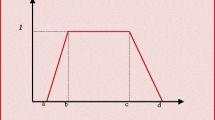Abstract
Fuzzy Data Envelopment Analysis (FDEA) is a tool for comparing the performance of a set of activities or organizations under uncertainty environment. Imprecise data in FDEA models is represented by fuzzy sets and FDEA models take the form of fuzzy linear programming models. Previous research focused on solving the FDEA model of the CCR (named after Charnes, Cooper, and Rhodes) type (FCCR). In this paper, the FDEA model of the BCC (named after Banker, Charnes, and Cooper) type (FBCC) is studied. Possibility and Credibility approaches are provided and compared with an α-level based approach for solving the FDEA models. Using the possibility approach, the relationship between the primal and dual models of FBCC models is revealed and fuzzy efficiency can be constructed. Using the credibility approach, an efficiency value for each DMU (Decision Making Unit) is obtained as a representative of its possible range. A numerical example is given to illustrate the proposed approaches and results are compared with those obtained with the α-level based approach.
Similar content being viewed by others
References
Arnade, C. A. (1994). “Using Data Envelopment Analysis to Measure International Agricultural Efficiency and Productivity,” United States Department of Agriculture, Economic Research Service, Technical Bulletin 1831, 1–30.
Banker, R. D., A. Charnes, and W. W. Cooper. (1984). “Some Models for Estimating Technical and Scale Inefficiency in Data Envelopment Analysis,” Management Science 30, 1078–1092.
Banker, R. D., H. Chang, and W. W. Cooper. (1996). “Simulation Studies of Efficiency, Returns to Scale and Misspecification with Nonlinear Functions in DEA,” Annals of Operations Research 66, 233–253.
Bertsimas, D. and J. N. Tsitsiklis. (1997). Introduction to Linear Optimization. Belmont, Massachusetts: Athena Scientific.
Charnes, A. and W. W. Cooper. (1959). “Chance-Constrained Programming,” Management Science 6, 73–79.
Charnes, A., W. W. Cooper, and E. Rhodes. (1978). “Measuring the Efficiency of Decision-Making Units,” European Journal of Operational Research 2, 429–444.
Charnes, A., W. W. Cooper, B. Golany, and L. Seiford. (1985). “Foundation Data Envelopment Analysis of Pareto-Koopmans Efficient Empirical Production Functions,” Journal of Econometrics 30, 91–107.
Charnes, A., W. W. Cooper, A. Y. Lewin, and L. M. Seiford. (1994). Data Envelopment Analysis: Theory, Methodology, and Application. London: Kluwer Academic Publishers.
Cooper, W. W., K. S. Park, and G. Yu. (1999). “IDEA and AR-IDEA: Models for Dealing with Imprecise Data in DEA,” Management Sciences 45, 597–607.
Cooper, W. W., L. M. Seiford, and K. Tone. (2000). Data Envelopment Analysis: A Comprehensive Text with Models, Applications, Reference and DEA-Solver Software. London: Kluwer Academic Publishers.
Dubois, D. and H. Prade. (1988). Possibility Theory: An Approach to Computerized Processing of Uncertainty. New York: Plenum Press.
Fang, S.-C. and S. Puthenpura. (1993). Linear Optimization and Extensions: Theory and Algorithms. Englewood Cliffs, New Jersey: Prentice Hall.
Guo, P. and H. Tanaka. (2001). “Fuzzy DEA: A Perceptual Evaluation Method,” Fuzzy Sets and Systems 119, 149–160.
Kao, C. and S.-T. Liu. (2000). “Fuzzy Efficiency Measures in Data Envelopment Analysis,” Fuzzy Sets and Systems 113, 427–437.
Lertworasirikul, S. (2002). Fuzzy Data Envelopment Analysis (DEA). North Carolina State University: Dissertation in Industrial Engineering.
Lertworasirikul, S., S.-C. Fang, J. A. Joines, and H. L. W. Nuttle. (2001). “A Possibility Approach to Fuzzy Data Envelopment Analysis,” the 8th International Conference on Fuzzy Theory and Technology.
Lertworasirikul, S., S.-C. Fang, J. A. Joines, and H. L. W. Nuttle. (2002). “Fuzzy Data Envelopment Analysis,” he 9th Bellman Continuum.
Lertworasirikul, S., S.-C. Fang, J. A. Joines, and H. L. W. Nuttle. (2003). “Fuzzy Data Envelopment Analysis (DEA): A Possibility Approach,” to appear in Fuzzy Sets and Systems.
Lertworasirikul, S., S.-C. Fang, J. A. Joines, and H. L. W. Nuttle. (2003). “Fuzzy Data Envelopment Analysis: A Credibility Approach.” In M. Nachtegael and J. L. Verdegay (eds.), Fuzzy Sets Based Heuristics for Optimization: Studies in Fuzziness and Soft Computing. New York: Physica Verlag.
Liu, B. (2001a). “Uncertain Programming: A Unifying Optimization Theory in Various Uncertain Environments,” Applied Mathematics and Computation 120, 227–234.
Liu, B. (2002). “Toward Fuzzy Optimization without Mathematical Ambiguity,” Fuzzy Optimization and Decision Making 1, 43–63.
Meada, Y., T. Entani, and H. Tanaka. (1998). “Fuzzy DEA with Interval Efficiency,” 6th European Congress on Intelligent Techniques and Soft Computing 2, 1067–1071.
Ross, S. M. (1993). Introduction to Probability Models. Orlando FL: Academic Press.
Ross, S. M. (1996). Stochastic Processes. New York: John Wiley & Sons, Inc.
Seiford, L. M. and R. M. Thrall. (1990). “Recent Development in DEA: The Mathematical Programming Approach to Frontier Analysis,” Journal of Econometrics 46, 7–38.
Sengupta, J. K. (1995). Dynamics of Data Envelopment Analysis: Theory of Systems Efficiency. London: Kluwer Academic Publishers.
Stanford Business Software, Inc. (2001). Http://www.sbsi-sol-optimize.com/Minos.htm
Zadeh, L. A. (1965). “Fuzzy Sets,” Information and Control 8, 338–353.
Zadeh, L. A. (1978). “Fuzzy Sets as a Basis for a Theory of Possibility,” Fuzzy Sets and Systems 1, 3–28.
Zimmermann, H. J. (1996). Fuzzy Set Theory and Its Application. London: Kluwer Academic Publishers.
Author information
Authors and Affiliations
Rights and permissions
About this article
Cite this article
Lertworasirikul, S., Fang, SC., Nuttle, H.L.W. et al. Fuzzy BCC Model for Data Envelopment Analysis. Fuzzy Optimization and Decision Making 2, 337–358 (2003). https://doi.org/10.1023/B:FODM.0000003953.39947.b4
Issue Date:
DOI: https://doi.org/10.1023/B:FODM.0000003953.39947.b4




